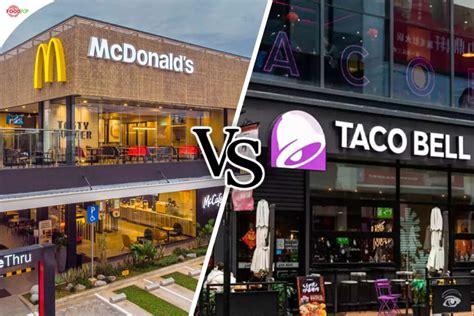
Taco Bell and McDonald’s are intensifying the fast-food competition with recent menu innovations, as Taco Bell introduces new Cheez-It-themed items while McDonald’s focuses on enhancing its McCrispy chicken sandwich line.
The fast-food landscape is heating up as Taco Bell and McDonald’s, two giants in the industry, unveil new menu items aimed at capturing consumer attention and market share. Taco Bell’s latest collaboration with Cheez-It has generated significant buzz, while McDonald’s is doubling down on its popular McCrispy chicken sandwich, signaling a renewed battle for dominance in the quick-service restaurant (QSR) sector. This intensified competition underscores the ongoing need for fast-food chains to innovate and adapt to evolving consumer preferences.
Taco Bell’s Cheez-It Collaboration: A Bold Move
Taco Bell is no stranger to innovative partnerships, and its latest venture with Cheez-It is generating considerable excitement. The collaboration features two new menu items: the Cheez-It Crunchwrap and the Cheez-It Supreme Pizza. These items incorporate a giant-sized Cheez-It cracker, offering a unique twist on Taco Bell classics.
The Cheez-It Crunchwrap includes a massive Cheez-It cracker serving as the base, filled with seasoned beef, nacho cheese sauce, lettuce, tomatoes, and reduced-fat sour cream, all wrapped in a grilled tortilla. This creation blends familiar Taco Bell flavors with the distinctive taste and texture of Cheez-It, creating a novel eating experience.
The Cheez-It Supreme Pizza takes the concept further, presenting a pizza-like dish with a giant Cheez-It crust topped with seasoned beef, diced tomatoes, cheese, and sour cream. This offering aims to capitalize on the widespread appeal of pizza while incorporating the iconic Cheez-It flavor.
These Cheez-It-themed items are currently being tested at a single Taco Bell location in Irvine, California, according to a Yahoo Lifestyle report. The test phase allows Taco Bell to gauge consumer interest and gather feedback before potentially launching the items nationwide. “This is a test, and tests don’t always lead to new things,” Taco Bell stated, emphasizing the exploratory nature of the initiative.
McDonald’s McCrispy Expansion: Focusing on Core Strengths
In contrast to Taco Bell’s experimental approach, McDonald’s is focusing on strengthening its core offerings with enhancements to its McCrispy chicken sandwich line. McDonald’s introduced the McCrispy in 2023, and it quickly became a popular item, prompting the company to expand the line with new variations.
The McCrispy is known for its crispy, juicy chicken fillet, served on a toasted potato roll with crinkle-cut pickles and either classic mayo or spicy mayo. McDonald’s is now introducing new McCrispy options, including flavored variations and promotional offerings, to maintain consumer interest and drive sales. While specific details on the new McCrispy variations were not provided in the Yahoo Lifestyle article, McDonald’s focus underscores the importance of building upon successful menu items.
The McCrispy has been a significant success for McDonald’s, contributing to the company’s overall growth and profitability. By expanding the McCrispy line, McDonald’s aims to further solidify its position in the competitive chicken sandwich market. “The McCrispy has been a game-changer for us,” a McDonald’s spokesperson noted, highlighting the sandwich’s positive impact on the company’s performance.
Market Context: The Competitive Fast-Food Landscape
The fast-food industry is characterized by intense competition, with chains constantly vying for customers’ attention and loyalty. Menu innovation is a critical strategy for attracting new customers and retaining existing ones. Chains often introduce limited-time offers (LTOs) and collaborate with other brands to create buzz and generate excitement.
Taco Bell and McDonald’s have both been active in launching new menu items and promotional campaigns. Taco Bell is known for its adventurous and often unconventional menu items, such as the Doritos Locos Tacos and the Quesalupa. These offerings have helped Taco Bell to differentiate itself from competitors and appeal to a younger demographic.
McDonald’s, on the other hand, tends to focus on more traditional menu items and value offerings. The company’s strength lies in its consistency, affordability, and widespread brand recognition. McDonald’s has also been investing in technology and digital initiatives to improve the customer experience and drive efficiency.
Consumer Trends: Evolving Preferences and Demands
Several consumer trends are shaping the fast-food industry, including a growing demand for healthier options, increased interest in plant-based alternatives, and a desire for convenience and value. Fast-food chains are responding to these trends by offering more salads, wraps, and vegetarian options. They are also investing in mobile ordering, delivery services, and loyalty programs to enhance convenience and reward customer loyalty.
The rise of food delivery services like Uber Eats and DoorDash has also had a significant impact on the fast-food industry. These services have made it easier for consumers to order food from their favorite restaurants and have created new opportunities for fast-food chains to reach a wider audience.
The Future of Fast Food: Innovation and Adaptation
The fast-food industry is expected to continue to evolve and adapt to changing consumer preferences and technological advancements. Menu innovation will remain a key driver of growth, with chains exploring new flavors, formats, and ingredients. Technology will also play an increasingly important role, with automation, artificial intelligence, and data analytics transforming the way fast-food restaurants operate.
The competition between Taco Bell and McDonald’s is likely to intensify in the coming years, as both chains seek to gain an edge in the market. Taco Bell will likely continue to experiment with bold and unconventional menu items, while McDonald’s will focus on strengthening its core offerings and improving the customer experience. Ultimately, the success of both chains will depend on their ability to understand and respond to the evolving needs and preferences of consumers.
The fast-food industry’s future hinges on innovation, adaptation, and a deep understanding of consumer needs. As Taco Bell and McDonald’s continue to evolve their menus and strategies, the competition will undoubtedly benefit consumers by providing a wider range of choices and higher levels of convenience.
Detailed Analysis of Taco Bell’s Cheez-It Collaboration
The Taco Bell and Cheez-It partnership is a strategic move designed to generate significant buzz and attract new customers. By leveraging the iconic Cheez-It brand, Taco Bell aims to tap into the snack’s widespread popularity and appeal. The collaboration represents a bold departure from Taco Bell’s traditional menu items and demonstrates the company’s willingness to experiment with unconventional flavors and formats.
The Cheez-It Crunchwrap and Cheez-It Supreme Pizza are designed to be visually appealing and Instagram-worthy, which is an important consideration in today’s social media-driven world. The giant-sized Cheez-It cracker is a distinctive feature that is sure to capture attention and generate online conversation.
The test phase in Irvine, California, is crucial for Taco Bell to gather valuable feedback from consumers before making a decision on a national launch. The company will be closely monitoring sales, customer satisfaction, and social media sentiment to assess the potential success of the Cheez-It-themed items.
One potential challenge for Taco Bell is ensuring that the Cheez-It cracker maintains its signature flavor and texture when incorporated into the Crunchwrap and Pizza. The company will need to carefully consider the preparation methods and ingredients to ensure that the final products meet consumer expectations.
Another challenge is managing the potential operational complexities of producing and serving the Cheez-It-themed items. The giant-sized Cheez-It cracker may require specialized equipment and training, which could add to the cost and complexity of operating Taco Bell restaurants.
Despite these challenges, the Taco Bell and Cheez-It collaboration has the potential to be a major success. The partnership represents a creative and innovative approach to menu development, and it demonstrates Taco Bell’s commitment to pushing the boundaries of fast-food cuisine.
In-Depth Look at McDonald’s McCrispy Strategy
McDonald’s strategy of expanding its McCrispy chicken sandwich line reflects the company’s focus on building upon its core strengths and capitalizing on successful menu items. The McCrispy has quickly become a popular choice among customers, and McDonald’s is seeking to leverage its momentum by introducing new variations and promotional offers.
The McCrispy’s success can be attributed to several factors, including its crispy texture, juicy chicken fillet, and flavorful sauces. The sandwich also benefits from McDonald’s widespread brand recognition and extensive marketing efforts.
By expanding the McCrispy line, McDonald’s aims to offer customers more variety and choice while maintaining the quality and consistency that they have come to expect from the brand. The company is likely to introduce new McCrispy options with different flavor profiles, toppings, and sauces to appeal to a wider range of tastes.
McDonald’s may also consider offering limited-time McCrispy variations with seasonal ingredients or promotional tie-ins. These limited-time offers can generate excitement and drive sales by creating a sense of urgency and exclusivity.
One potential challenge for McDonald’s is maintaining the quality and consistency of the McCrispy as the line expands. The company will need to ensure that all McCrispy variations meet the same high standards that have made the original sandwich so popular.
Another challenge is differentiating the new McCrispy options from the original sandwich while still maintaining the core characteristics that customers love. McDonald’s will need to strike a balance between innovation and familiarity to ensure that the new McCrispy variations are both appealing and recognizable.
Despite these challenges, McDonald’s is well-positioned to successfully expand its McCrispy chicken sandwich line. The company has a proven track record of launching and marketing successful menu items, and it has the resources and infrastructure to support the growth of the McCrispy brand.
The Broader Implications for the Fast-Food Industry
The menu innovations from Taco Bell and McDonald’s highlight the broader trends and challenges facing the fast-food industry. In a highly competitive market, chains must constantly innovate and adapt to changing consumer preferences to stay ahead of the curve.
Menu innovation is not just about introducing new items; it’s also about improving existing ones and finding new ways to present familiar flavors. Chains are increasingly using data analytics and customer feedback to inform their menu development decisions.
Technology is also playing a significant role in the fast-food industry, with chains investing in mobile ordering, delivery services, and automated kiosks to improve the customer experience and drive efficiency.
Sustainability is another important consideration for fast-food chains, as consumers are increasingly concerned about the environmental impact of their food choices. Chains are exploring ways to reduce their carbon footprint, use more sustainable packaging, and source ingredients from local and ethical suppliers.
The fast-food industry is also facing challenges related to labor costs, supply chain disruptions, and changing regulations. Chains must find ways to manage these challenges while still providing affordable and convenient food to customers.
The competition between Taco Bell and McDonald’s is a microcosm of the broader dynamics shaping the fast-food industry. Both chains are constantly seeking to innovate, adapt, and improve to stay ahead in a highly competitive market.
Consumer Reaction and Social Media Buzz
The announcement of Taco Bell’s Cheez-It collaboration and McDonald’s McCrispy expansion has generated significant buzz on social media. Consumers have been sharing their opinions, reactions, and anticipation for the new menu items.
The Cheez-It Crunchwrap and Cheez-It Supreme Pizza have sparked a mix of excitement and skepticism among Taco Bell fans. Some consumers are eager to try the unique combination of Taco Bell flavors and Cheez-It crackers, while others are unsure about the concept.
Social media platforms like Twitter and Instagram have been flooded with posts and comments about the Cheez-It-themed items. Many users have expressed their desire for Taco Bell to launch the items nationwide, while others have shared their concerns about the potential for long lines and limited availability.
The McCrispy expansion has also generated considerable interest among McDonald’s customers. Many consumers have expressed their excitement about the prospect of new McCrispy variations and have shared their suggestions for potential flavor combinations and toppings.
Social media sentiment towards the McCrispy expansion has been largely positive, with many consumers praising the original McCrispy sandwich and expressing their confidence that the new variations will be just as good.
The social media buzz surrounding the Taco Bell and McDonald’s menu innovations underscores the importance of social media marketing in the fast-food industry. Chains are increasingly using social media platforms to engage with customers, promote new products, and gather feedback.
The Role of Partnerships and Collaborations
The Taco Bell and Cheez-It partnership highlights the growing trend of collaborations and partnerships in the fast-food industry. Chains are increasingly teaming up with other brands to create new and exciting menu items and marketing campaigns.
Collaborations can be a win-win for both partners, allowing them to leverage each other’s brand recognition, customer base, and marketing expertise. Taco Bell’s partnership with Cheez-It is a prime example of how a collaboration can generate significant buzz and attract new customers.
Other examples of successful fast-food collaborations include the Doritos Locos Tacos at Taco Bell, the McRib at McDonald’s (which often involves strategic timing and limited availability to build hype), and various co-branded menu items and promotions involving popular snack brands or celebrities.
Collaborations can also help chains to differentiate themselves from competitors and stay ahead of the curve. By partnering with innovative and well-known brands, chains can create unique and memorable experiences for customers.
The success of a collaboration depends on several factors, including the compatibility of the brands, the creativity of the menu items, and the effectiveness of the marketing campaign. Chains must carefully consider these factors when selecting partners and developing collaborative products.
The Economic Impact and Market Implications
The menu innovations from Taco Bell and McDonald’s have significant economic and market implications for the fast-food industry. New menu items can drive sales, increase market share, and boost brand awareness.
The success of the Cheez-It Crunchwrap and Cheez-It Supreme Pizza could potentially generate millions of dollars in revenue for Taco Bell. The McCrispy expansion could also significantly contribute to McDonald’s overall sales and profitability.
The menu innovations also have implications for the suppliers of ingredients and packaging. The increased demand for Cheez-It crackers and McCrispy chicken fillets could benefit the companies that produce these items.
The menu innovations also have implications for the employees of Taco Bell and McDonald’s. The increased sales and customer traffic could lead to more job opportunities and higher wages.
The fast-food industry is a major contributor to the U.S. economy, employing millions of people and generating billions of dollars in revenue each year. The menu innovations from Taco Bell and McDonald’s demonstrate the dynamism and innovation that characterize the industry.
The Long-Term Strategies of Taco Bell and McDonald’s
The menu innovations from Taco Bell and McDonald’s reflect their long-term strategies for growth and success. Taco Bell is focused on innovation, experimentation, and appealing to a younger demographic. McDonald’s is focused on consistency, affordability, and building upon its core strengths.
Taco Bell’s strategy involves pushing the boundaries of fast-food cuisine and creating unique and memorable experiences for customers. The company is willing to take risks and experiment with unconventional flavors and formats to attract attention and generate buzz.
McDonald’s strategy involves focusing on what it does best: providing affordable, convenient, and consistent food to millions of customers around the world. The company is committed to improving the customer experience, investing in technology, and building upon its core menu items.
Both Taco Bell and McDonald’s are adapting to changing consumer preferences and technological advancements. They are investing in mobile ordering, delivery services, and loyalty programs to enhance convenience and reward customer loyalty.
The long-term success of both Taco Bell and McDonald’s will depend on their ability to continue to innovate, adapt, and improve in a highly competitive market.
Future Trends in Fast Food
Several future trends are expected to shape the fast-food industry in the coming years. These include:
- Increased automation: Fast-food restaurants are increasingly using automation to improve efficiency, reduce labor costs, and enhance the customer experience. Examples of automation include self-ordering kiosks, automated fryers, and robotic food preparation systems.
- Personalized nutrition: Fast-food chains are beginning to offer more personalized nutrition options, allowing customers to customize their meals based on their dietary needs and preferences. This trend is driven by growing consumer awareness of health and wellness.
- Plant-based alternatives: The demand for plant-based alternatives to meat and dairy is growing rapidly, and fast-food chains are responding by offering more vegetarian and vegan options.
- Sustainable packaging: Consumers are increasingly concerned about the environmental impact of food packaging, and fast-food chains are exploring ways to use more sustainable materials and reduce waste.
- Digital integration: Fast-food chains are increasingly integrating digital technology into all aspects of their operations, from mobile ordering and delivery to customer loyalty programs and data analytics.
- Emphasis on convenience: The fast-food industry will continue to prioritize convenience, with chains offering more options for mobile ordering, drive-thru service, and delivery.
- Global expansion: Fast-food chains will continue to expand their presence in international markets, particularly in developing countries where demand for affordable and convenient food is growing.
The fast-food industry is dynamic and constantly evolving. Chains that are able to adapt to these future trends will be best positioned for long-term success.
Frequently Asked Questions (FAQ)
-
What are the new menu items being introduced by Taco Bell and McDonald’s?
Taco Bell is testing Cheez-It Crunchwraps and Cheez-It Supreme Pizzas, featuring giant-sized Cheez-It crackers. McDonald’s is expanding its McCrispy chicken sandwich line with new variations. Specific details on the McCrispy expansion were not provided in the Yahoo Lifestyle article, but it involves additions and flavor variations to the existing McCrispy menu.
-
Where is Taco Bell testing the new Cheez-It items?
The Cheez-It Crunchwrap and Cheez-It Supreme Pizza are currently being tested at a single Taco Bell location in Irvine, California.
-
Why are Taco Bell and McDonald’s introducing new menu items?
To attract new customers, retain existing ones, and increase market share in the highly competitive fast-food industry. Menu innovation is a key strategy for staying relevant and meeting evolving consumer preferences.
-
What is the significance of Taco Bell’s collaboration with Cheez-It?
The collaboration leverages the widespread popularity of the Cheez-It brand to create buzz and attract new customers. It demonstrates Taco Bell’s willingness to experiment with unconventional flavors and formats, differentiating it from competitors. It is also part of Taco Bell’s strategy to remain relevant and innovative in the fast-food market.
-
What is McDonald’s strategy behind expanding the McCrispy line?
McDonald’s is focusing on building upon its core strengths and capitalizing on the success of the McCrispy chicken sandwich. By introducing new variations, McDonald’s aims to offer customers more variety while maintaining the quality and consistency of its core offerings. This reflects McDonald’s strategy of strengthening popular menu items to ensure customer satisfaction and loyalty.









